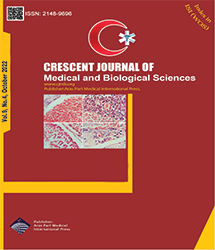
| Original Article | |
| Anti-cancer Effects of Methotrexate in Combination With Melissa officinalis on HeLa Cancer Cell Line | |
| Parviz Faraji1,2, Mostafa Araj-Khodaei1,3, Amir Jafari4, Maryam Ghaffari2, Reza Mohammadinasab5, Sanaz Hamedeyazdan6, Miguel de la Guardia7, Jafar Ezzati Nazhad Dolatabadi8 | |
| 1Department of Persian Medicine, School of Traditional Medicine, Tabriz University of Medical Sciences, Tabriz, Iran 2Student Research Committee, Tabriz University of Medical Sciences, Tabriz, Iran 3Neurosciences Research Center, Aging Research Institute, Tabriz University of Medical Sciences, Iran 4Pharmaceutical Analysis Research Center, Tabriz University of Medical Sciences, Tabriz, Iran 5Department of History of Medicine, School of Traditional Medicine, Tabriz University of Medical Sciences, Tabriz, Iran 6Department of Pharmacognosy, Faculty of Pharmacy, Tabriz University of Medical Sciences, Tabriz, Iran 7Department of Analytical Chemistry, University of Valencia, Dr. Moliner 50, 46100, Burjassot, Valencia, Spain 8Drug Applied Research Center, Tabriz University of Medical Sciences, Tabriz, Iran |
|
|
CJMB 2022; 9: 189-194 DOI: 10.34172/cjmb.2022.31 Viewed : 3736 times Downloaded : 3375 times. Keywords : Methotrexate, Melissa officinalis, HeLa cancer cells, MTT assay, Flow cytometry |
|
| Full Text(PDF) | Related Articles | |
| Abstract | |
Objectives: One of the well-accepted beliefs about natural products, considering the advances of recently appearing new edges and features of herbal medicine, is paying more attention to cancer treatments. However, they have not been properly studied with reasonable/reliable clinical trials in human subjects in most cases. Therefore, seeking in vitro effects of herbs like Melissa officinalis (MO) in cancer therapy to identify the involved possible mechanism in conjugation with configurative/morphological aspects of treated cells seems quite necessary. In this study, we evaluated the co-treatment effect of anti-cancer drug methotrexate (MTX) and MO on HeLa cancer cells. Methods: MTT assay was applied to assess the quantitative cytotoxicity effect of both MTX and Mo. Apoptosis assay via flow cytometry was used to determine the amount of apoptotic and necrotic cells. To further investigate the anti-cancer effects, DAPI staining and DNA ladder assays are used qualitatively to detect changes in the nuclei of cells that are a sign of apoptosis occurring and morphological modifications of DNA. Results: MTX and MO mixture showed high cytotoxicity and apoptosis rate compared to untreated cells. Furthermore, the morphological changes of MTX and MO mixture were more evident than that of single MO, MTX, and control groups. Conclusions: These data regarding cell growth reduction and apoptosis induction in HeLa cancer cells showed that MTX and MO mixture can be an appropriate platform for cancer therapy. |
Cite By, Google Scholar
Google Scholar
PubMed
Online Submission System
 CJMB ENDNOTE ® Style
CJMB ENDNOTE ® Style
 Tutorials
Tutorials
 Publication Charge
Medical and Biological Research Center
About Journal
Publication Charge
Medical and Biological Research Center
About Journal
Aras Part Medical International Press Editor-in-Chief
Arash Khaki
Deputy Editor
Zafer Akan



















